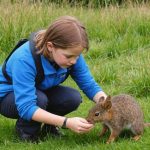Flystrike poses a significant risk to outdoor rabbits, especially in humid conditions. Without timely detection and preventative measures, it can lead to severe health issues. This guide offers practical tips to help you spot early signs of flystrike and maintain your rabbits' well-being. By understanding environmental factors and implementing effective strategies, you can create a safer habitat for your furry friends. Discover how to keep your rabbits healthy and comfortable, even during challenging weather.
Understanding Flystrike in Rabbits
Exploring the essentials of rabbit health and outdoor rabbit care.
En parallèle : Crafting a Safe and Stimulating Indoor Cat Garden: A Creative Guide for Feline Wellness
What is Flystrike?
Flystrike is a severe condition affecting rabbit health, where flies lay eggs on the rabbit's skin, leading to maggot infestation. This condition can rapidly become life-threatening, making timely detection crucial. Rabbits with wet or soiled fur are particularly vulnerable, highlighting the importance of regular grooming and cleanliness.
Causes of Flystrike
Several factors contribute to flystrike, including poor hygiene, obesity, and wounds. Outdoor rabbit care requires vigilance, as conditions outside can exacerbate these factors. Flies are attracted to damp and dirty environments, making it essential to maintain a clean habitat for your rabbit.
A lire aussi : Effective Strategies to Protect Your Fish Pond from Herons and Other Predatory Threats
Impact of Humid Conditions
Humidity plays a significant role in the risk of flystrike. Warm, moist environments accelerate egg hatching, increasing the threat. During humid weather, extra precautions should be taken, such as:
- Regularly checking your rabbit for signs of flystrike
- Ensuring dry and clean living conditions
- Using preventive treatments if necessary
By understanding these aspects, rabbit owners can better protect their pets from the dangers of flystrike and maintain their overall health. Taking proactive steps in flystrike prevention ensures a safer environment for rabbits, particularly those housed outdoors.
Identifying Early Signs of Flystrike
Recognizing symptoms and ensuring rabbit well-being.
Behavioral Changes in Affected Rabbits
Detecting flystrike symptoms early can be lifesaving. Affected rabbits often exhibit noticeable behavioral changes. You may observe your rabbit becoming lethargic, losing interest in food, or hiding more frequently. These changes can indicate distress and warrant immediate attention.
Physical Signs to Look For
In addition to behavioral shifts, there are specific physical signs that can help identify flystrike. Check for any unusual odors, damp fur, or visible maggots. The presence of irritated, red skin is also a critical indicator. Regularly inspecting your rabbit’s hindquarters can aid in early detection.
Importance of Regular Health Checks
Consistent health monitoring is vital for preventing flystrike. Establish a routine to examine your rabbit’s skin and fur, particularly in warm, humid months. This proactive approach facilitates the early identification of any flystrike symptoms.
Checklist for Monitoring:
- Observe changes in eating and activity levels
- Inspect fur for dampness and cleanliness
- Look for skin irritation or maggots
By understanding and identifying these signs, you can ensure timely intervention, safeguarding your rabbit’s health and well-being. Regular checks are a simple yet effective strategy in managing the risk of flystrike.
Preventative Measures for Humid Conditions
Ensuring optimal rabbit care and humidity management.
Keeping Living Areas Clean and Dry
Maintaining a clean and dry environment is crucial for effective flystrike prevention. Regularly clean your rabbit’s habitat, removing any soiled bedding or uneaten food. This reduces the attraction for flies and helps manage humidity levels. Use absorbent materials for bedding to keep areas dry.
Using Fly Repellents and Natural Deterrents
Incorporate fly repellents and natural deterrents to protect your rabbits. Products such as citronella or eucalyptus oil can be effective. However, ensure these are safe for rabbits. Natural options, like planting lavender or mint around outdoor enclosures, can also deter flies.
Importance of Proper Ventilation in Outdoor Habitats
Proper ventilation is essential in managing humidity within outdoor rabbit habitats. Ensure there is adequate airflow to prevent moisture build-up. Position enclosures in shaded areas to avoid direct sunlight, which can increase temperatures and humidity.
Checklist for Humidity Management:
- Clean and replace bedding regularly
- Use safe fly repellents and plant deterrents
- Ensure sufficient airflow and shade
By implementing these rabbit care tips, you can significantly reduce the risk of flystrike, ensuring a healthier environment for your rabbits. Prioritizing these measures not only protects your pets but also enhances their overall well-being.
Environmental Management for Outdoor Rabbits
Ensuring safety and comfort in outdoor rabbit habitats.
Suitable Outdoor Environments
Creating a suitable outdoor environment is crucial for your rabbit’s well-being. The habitat should be spacious, secure, and provide ample opportunities for exercise. Opt for enclosures with robust fencing to protect against predators. The ground surface should be soft yet firm, preventing injury while allowing for natural behaviors like digging.
Strategies for Enhancing Habitat Safety
Enhancing habitat safety involves several strategies. Regularly inspect for potential hazards such as sharp objects or toxic plants. Incorporate tunnels and hideouts to offer security and mental stimulation. Ensure that the enclosure is escape-proof, with secure locks and barriers.
Safety Strategies:
- Inspect for hazards weekly
- Secure all exits and entrances
- Provide tunnels and hideouts
Importance of Shade and Shelter
During humid weather, the importance of providing adequate shade and shelter cannot be overstated. Position enclosures in shaded areas to protect rabbits from direct sunlight. Use weather-resistant materials to construct shelters that offer respite from rain and heat, ensuring comfort and reducing stress.
By focusing on these environmental care aspects, you can create a safe and enriching rabbit habitat. This proactive approach ensures outdoor rabbit safety, promoting a healthy and happy life for your furry companions.
Hygiene Practices to Prevent Flystrike
Ensuring optimal rabbit hygiene and cleanliness.
Regular Grooming and Bathing Practices
Maintaining rabbit hygiene is essential for flystrike control. Regular grooming helps remove dirt and loose fur, reducing the risk of fly attraction. While rabbits generally keep themselves clean, occasional bathing might be necessary, especially for long-haired breeds. Use rabbit-safe products and ensure complete drying to prevent dampness.
Importance of Litter Box Maintenance
A clean litter box is crucial in maintaining cleanliness and controlling odors that attract flies. Regularly change the litter and sanitize the box to ensure a hygienic environment. This practice not only prevents flystrike but also promotes overall rabbit health.
Litter Box Maintenance Tips:
- Change litter daily
- Disinfect weekly
- Use absorbent materials
Tips for Maintaining a Clean Outdoor Space
For outdoor rabbits, keeping their habitat clean is vital. Regularly remove waste and uneaten food to minimize fly attraction. Use a rake to clear debris and ensure proper drainage to prevent water accumulation. A clean outdoor space is a cornerstone of effective flystrike control.
By prioritizing these hygiene practices, you can significantly lower the risk of flystrike, ensuring a safer and healthier environment for your rabbits.
Remedies and Veterinary Suggestions
Exploring effective rabbit treatment and care options.
Common Treatments for Flystrike
When dealing with flystrike, immediate rabbit treatment is essential. Veterinary care often includes cleaning the affected area and removing maggots. Topical antibiotics may be applied to prevent infection. In severe cases, veterinary care might require hospitalization for intensive treatment.
When to See a Veterinarian
Recognizing when to seek veterinary care is crucial. If you notice signs of distress or maggot presence, consult a veterinarian immediately. Delaying rabbit treatment can worsen the condition. A professional can assess the severity and provide the necessary flystrike remedies.
Preventative Veterinary Care and Vaccinations
Preventative measures are vital in protecting rabbits from flystrike. Regular check-ups and vaccinations are recommended as part of comprehensive veterinary care. Discuss with your vet about preventive treatments, such as fly repellents or specialized diets, to enhance your rabbit’s resistance to pests.
Checklist for Veterinary Visits:
- Schedule regular health checks
- Discuss vaccination options
- Inquire about preventive treatments
By understanding these flystrike remedies and when to seek veterinary care, rabbit owners can ensure timely and effective rabbit treatment. This proactive approach is key to maintaining rabbit health and well-being.
General Care Advice for Outdoor Rabbits
Enhancing rabbit health care and management for outdoor wellbeing.
Nutrition Tips for Outdoor Rabbits
Proper nutrition is fundamental to maintaining rabbit health care. Outdoor rabbits require a balanced diet rich in fiber to support their digestive systems. Fresh hay should be available at all times, complemented by leafy greens and a small portion of pellets.
Nutritional Checklist:
- Unlimited fresh hay
- Daily greens (e.g., kale, romaine lettuce)
- Limited pellets
Social Needs and Enrichment Activities
Outdoor rabbit management should include addressing their social needs. Rabbits are social animals, thriving on interaction. Consider adopting a bonded pair or ensuring regular human interaction. Enrichment activities, such as tunnels and chew toys, are essential for mental stimulation and physical exercise, enhancing their overall wellbeing.
Enrichment Ideas:
- Provide tunnels and hideouts
- Offer safe chew toys
- Schedule daily playtime
Seasonal Care Adjustments for Rabbits in Humid Climates
In humid climates, rabbit wellbeing requires specific adjustments. Ensure adequate shade and ventilation to prevent overheating. Regularly groom to avoid matting and dampness. Adjust diet to include more water-rich vegetables during hot months to keep rabbits hydrated.
Seasonal Care Tips:
- Increase ventilation
- Monitor hydration
- Adjust grooming frequency
By focusing on these aspects, you can significantly enhance the wellbeing of your outdoor rabbits, ensuring they lead healthy and enriched lives.











